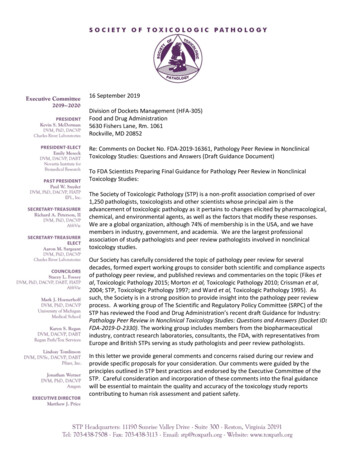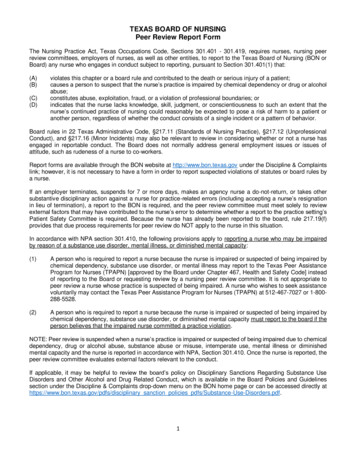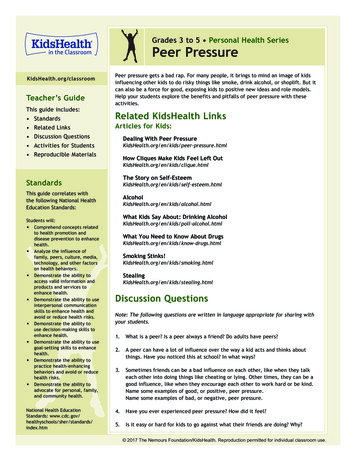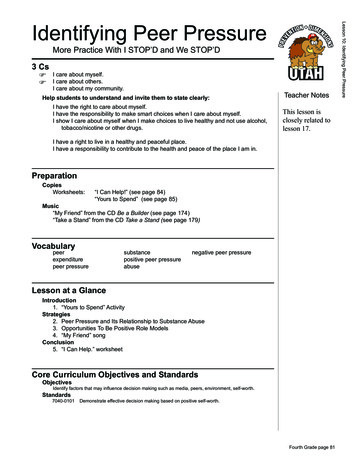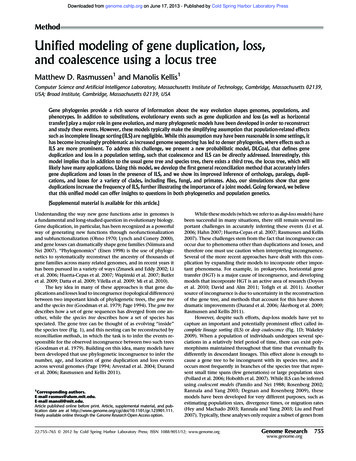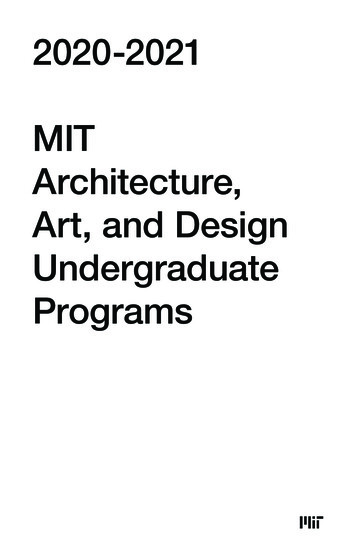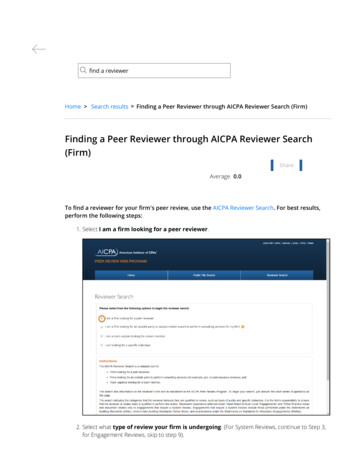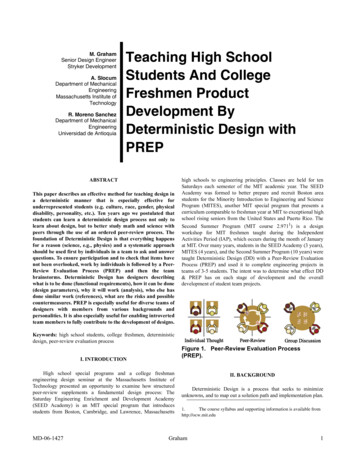
Transcription
M. GrahamSenior Design EngineerStryker DevelopmentA. SlocumDepartment of MechanicalEngineeringMassachusetts Institute ofTechnologyR. Moreno SanchezDepartment of MechanicalEngineeringUniversidad de AntioquiaTeaching High SchoolStudents And CollegeFreshmen ProductDevelopment ByDeterministic Design withPREPABSTRACTThis paper describes an effective method for teaching design ina deterministic manner that is especially effective forunderrepresented students (e.g. culture, race, gender, physicaldisability, personality, etc.). Ten years ago we postulated thatstudents can learn a deterministic design process not only tolearn about design, but to better study math and science withpeers through the use of an ordered peer-review process. Thefoundation of Deterministic Design is that everything happensfor a reason (science, e.g., physics) and a systematic approachshould be used first by individuals in a team to ask and answerquestions. To ensure participation and to check that items havenot been overlooked, work by individuals is followed by a PeerReview Evaluation Process (PREP) and then the teambrainstorms. Deterministic Design has designers describingwhat is to be done (functional requirements), how it can be done(design parameters), why it will work (analysis), who else hasdone similar work (references), what are the risks and possiblecountermeasures. PREP is especially useful for diverse teams ofdesigners with members from various backgrounds andpersonalities. It is also especially useful for enabling introvertedteam members to fully contribute to the development of designs.high schools to engineering principles. Classes are held for tenSaturdays each semester of the MIT academic year. The SEEDAcademy was formed to better prepare and recruit Boston areastudents for the Minority Introduction to Engineering and ScienceProgram (MITES), another MIT special program that presents acurriculum comparable to freshman year at MIT to exceptional highschool rising seniors from the United States and Puerto Rico. TheSecond Summer Program (MIT course 2.9711) is a designworkshop for MIT freshmen taught during the IndependentActivities Period (IAP), which occurs during the month of Januaryat MIT. Over many years, students in the SEED Academy (3 years),MITES (4 years), and the Second Summer Program (10 years) weretaught Deterministic Design (DD) with a Peer-Review EvaluationProcess (PREP) and used it to complete engineering projects inteams of 3-5 students. The intent was to determine what effect DD& PREP has on each stage of development and the overalldevelopment of student team projects.Keywords: high school students, college freshmen, deterministicdesign, peer-review evaluation processFigure 1. Peer-Review Evaluation Process(PREP).I. INTRODUCTIONHigh school special programs and a college freshmanengineering design seminar at the Massachusetts Institute ofTechnology presented an opportunity to examine how structuredpeer-review supplements a fundamental design process: TheSaturday Engineering Enrichment and Development Academy(SEED Academy) is an MIT special program that introducesstudents from Boston, Cambridge, and Lawrence, MassachusettsMD-06-1427II. BACKGROUNDDeterministic Design is a process that seeks to minimizeunknowns, and to map out a solution path and implementation plan.1.The course syllabus and supporting information is available fromhttp://ocw.mit.eduGraham1
It has its origins in precision engineering [1, 2] and axiomatics [3],but it uses a more relaxed format that encourages designers to feelfree to think hair-raising unstructured thoughts which preserves thefun of design. However, it insists that eventually the designer getsaround to covering essential issues needed to describe, develop andrealize a successful design. DD asks the designer to complete thefollowing tasks when developing a design:1.Identifying the problem and breaking it into a list of requiredfunctions2.Determining a parameter to meet each function3.Conducting analysis to gauge the effectiveness of theselected parameter4.Researching references/similar developments and comparingto analysis of selected parameter5.Conducting risk analysis6.Planning countermeasures to negate the risksCollectively we suggest presenting this type of information ina FRDPARRC table. (Functional Requirements, Design Parameters,Analysis, References, Risks, Counter-Measures). Each stage ofdevelopment occurs in three phases that make up PREP (Figure 1):1.Individual thought2.Peer-review (without discussion)3.Discussion (brainstorming) and selectionThe overall process is similar to the Rohrbach method [4], butduring the individual thought phase individuals are required to notonly think wild and free, but to address essential issues (as notedabove). Individuals independently develop ideas for the stage ofdevelopment, team members gather around a table and pass theirideas to their neighbor to be silently reviewed - the processcontinues until each individual has their work reviewed by everyother team member, and then team members discuss the ideas theyhave reviewed to synthesize ideas into the "best" idea. Duringdiscussion, weighted selection occurs to determine the top idea,while also identifying strong points from all ideas and how the mostfavorable characteristics can be incorporated in the top idea [5].Weighting is decided based on factors such as objectives, customerrequirements, and interests of stakeholders. PREP is thus especiallyuseful for diverse teams of designers with members from variouscultures, races, genders, physical disabilities, and personalitiesbecause it first empowers people to contribute without fear ofconfrontation that often occurs in group brainstorming sessions.Furthermore, it provides a written record of who first came up witha concept which can be valuable for assessing promotions or forinventorship.Idea development is also taught to happen in a sequence ofthree stages from coarse to fine: Strategies, Concepts, and Modules.At each step of creation (strategy, concept, and modules)deterministic design is used. With PREP, individual design teammembers create (and write down their ideas), peer-review the ideasof teammates, and then discuss and select an idea as a team. It iswith this crucial process, we have found in 10 years of teaching thatunderrepresented and shy people are virtually guaranteed to becomefully contributing members of a design team. In addition, we havealso observed that extroverted team members are happy to bringMD-06-1427forth a great idea from a shy team member if the latter does notbring it up during brainstorming. All win in this situation.The DD & PREP process is repeated for each of the threestages: Individual Thought, the first phase of PREP, constitutes thefirst action of each of the three stages of developing ideas. Duringthe second phase in developing ideas, a peer-review process isemployed, where (N) people circulate their Milestone Reports to theother (N-1) people for comments, similar to the Rohrbach method.Group discussion and selection is the third phase, which helpsteams solve personal creativity deadlocks and helps to ensurenothing has been overlooked as the team progresses to the nextstage. PREP maintains the creativity of individuals and the power ofteams, and provides a written record for how ideas evolve.PREP reduces time to design by getting everyone fullyinvolved, and is a framework for understanding what team membersare thinking [6].III. METHODSAll courses involved in this study used DD & PREP, thoughthe course objectives varied.In the SEED Academy, high school freshmen and sophomoreswere introduced to mechanical and civil engineering respectivelyand used Deterministic Design in teams of 4 students to developremote control cars and bridges. Cars were designed for speed,power, or a balance of the two. Bridge designs types were beam,arch, and suspension. Students were introduced to mechanicalengineering during the spring semester of their freshman year, asemester before being introduced to civil engineering during the fallsemester of their sophomore year. This was conducted for 3 years, 3semesters of mechanical engineering and 3 semesters of civilengineering.In MITES, high school rising seniors were given a designchallenge similar to sophomore mechanical engineering students atMIT in Design and Manufacturing I (MIT course 2.007). Eachstudent in 2.007 is given the task of designing a machine to competeon an obstacle course against machines designed by fellowclassmates. Individuals in select lab sections develop machinesusing Deterministic Design and their ideas are peer-reviewed by labmates throughout development. MITES students also developmachines to compete on an obstacle course, though they work inteams of 3-5 students and complete their projects in 5 weeks asopposed to a semester. This was conducted for 4 summers.For each of the last 10 years, in the Second Summer Program,MIT freshmen were tasked with designing and developing productsthat ranged from games and toys to office supplies to learning toolsand so on. Students worked in teams of 3-5 students usingDeterministic Design with PREP for 20 hours a week for 3 weeksduring the January Independent Activities Period (IAP) at MIT.IV. RESULTSThe ability of students to use Deterministic Design improvedwith education level, but the benefit of using PREP was consistentthroughout. In the 9th grade SEED Academy mechanicalengineering course, students generally had trouble following theDeterministic Design process. The math proficiency of the majorityGraham2
of these students was well below acceptable for their grade leveland for most, if not all, it was their first experience with a formaldesign project. It was also their first experience with reviewing thework of peers. Throughout the course, the process used by studentswas more trial and error guided by a design process thanDeterministic Design, but students generally were able to grasp theconcept of identifying risks and trying to think of possiblecountermeasures. However, they completed the work using thethree phases of PREP, Individual Thought, Written Peer-Review,and Group Discussion and Selection. Although they had difficultyproperly following the ordered process of Deterministic Design, sothey were working on, reviewing, and discussing different parts ofdevelopment simultaneously, nevertheless using PREP added theteam's input to the overall development.With 10th graders interested in civil engineering, the studentshad been introduced to a formal design process, though overall theirmath proficiency remained below acceptable for their grade level.Still, they were able to develop bridges using Deterministic Designand their experience with PREP allowed less knowledgeablestudents to learn from peers. Often times, students would learnthings through PREP that they did not know how to, or were tooembarrassed to ask. The input they received on their individualcontributions to the team project helped them become bettercontributors and less assistance was required from staff than in the9th grade mechanical engineering focused course. Other factors thatcould have contributed to the improvements seen from 9th to 10thgrade include more informed selection process of students for theprogram, Preliminary Scholastic Aptitude Test (PSAT) preparationexercises, and gained experience of instructors. However, yearlymath diagnostic exams indicate that the math proficiency ofstudents admitted to the program had not improved and PSATspecific preparation exercises were only recently introduced(students were always given assignments targeting areas thatneeded improvement discovered by way of the math diagnosticexam).The rising high school seniors in the MITES programgenerally had very little trouble following the Deterministic Designprocess. Several had experience working in teams and some hadcompleted recreational and/or competitive design projects. Themath and science proficiency of students in the MITES programwas well above the national average. Students in the MITESprogram were strong independent workers, but their scholasticaptitude did not always lead individuals to developing great ideas.However, the teams that were persistent in their use of PREP sawsteady increases in the novelty and sophistication of their designs,which directly correlated with their performance in the final designcompetition with their classmates (see Figure 2). Team participationwas determined by questionnaires and interviews with studentsupon completion of the course and direct observation by the courseinstructors throughout the course; use of PREP and hours spentworking together in lab were the metrics considered. Designsophistication was measured by the correct use of machine elementsand the overall craftsmanship of machines. Place in the competitionwas self-determining year after year, as performance results werebased on scoring from each round. The teams with the mostcollaboration developed the most sophisticated designs and placedhighest in the final competitions. Conversely, the teams with theleast collaboration developed the least sophisticated designs andplaced lowest in the competitions. Teams that placed between firstMD-06-1427and last had comparable collaboration and design sophistication.Their place in the competition was determined more by the amountof time they spent practicing operation of their machine before thecompetition, which was a factor for the first and last place teams aswell. The first place team finished their design and manufacturingearliest and had considerable time to test and modify their machine.The team that placed last in the competition had less time for testingand modifications than any other team. Prior design experience is afactor that may have contributed to the performance of teams,though teams were selected randomly to avoid bias.Figure 2. MITES 2005 Engineering DesignPerformance.MIT freshmen in the Second Summer Program learnDeterministic Design with PREP in one lecture and use it to designand develop prototypes that satisfy a designated design objective.The students in the Second Summer Program generally areexceptional independent workers and have experience working inteams. However, when asked many of these students describe theirpast teamwork experiences as situations where their contribution toproject completion greatly outweighed the contributions of theirteammates; this assessment is unsubstantiated. Students in theprogram are proficient to very proficient in math and science, butthe overall proficiency is more or less the MIT average. Teams arerandomly selected and begin working on their project immediatelyafter being introduced to Deterministic Design with PREP on thefirst day of class. The Second Summer Program has a 10 yearhistory of students working in teams to complete projects usingDeterministic Design with PREP. Students from 2001 to 2006completed 14 question questionnaires regarding their use ofDeterministic Design with PREP. The questionnaires covered topicsfrom time spent working independently and with teammates in andout of the machine shop to how use of the process improvedindependent and group work habits and performance. Each yearupon completion of the Second Summer Program, most to all of thestudents (depending on what is available) are offered summerinternships with sponsoring companies. The companies expresstheir contentment with the performance of the students throughcontinued support for the program and rehires of the students forreturn internships and offers after graduation. The Second SummerProgram was founded with the purpose of preparing students forGraham3
summer internships. We have found completing projects usingDeterministic Design with PREP to be an effective method forpreparing Second Summer Program students for summerinternships and improving their scholastic performance in general(see Figure 3 and Figure 4). Out of 34 survey respondents from2001 - 2006, over 65% agreed the Second Summer Programprepared them for summer internships and improved theirperformance as students. We believe we saw these results becauseDeterministic Design not only provides a framework for creativedevelopment, but work and development in general. Also PREP is adecidedly constructive approach to working with others andimproves communication skills. Peer-review is conducted withouttalking, so students become effective at written communication.Students also become effective at reading the work of others andproviding constructive criticism. And group discussion helpsstudents become comfortable with oral communication. In fact,students surveyed reported a 93.9% average comfort rating withpresenting their ideas to the rest of the team and an 86.7% averageagreement that their ideas were recognized by the rest of team (seeFigure 5 and Figure 6). However, perhaps the greatest testament tothe satisfaction of students with Deterministic Design with PREP ishow often those who learned the process continue to use theapproach in their work with others (see Figure 7). In their currentwork with others, over 45% of former students use PREP 75% ofthe time and over 75% of them use PREP at least 50% of the time.A factor that likely influenced the rapid adaptation of SecondSummer Program students to the use of Deterministic Design withPREP is the instructor (teacher and teaching assistants) to studentratio, which was significantly greater than those of SEED Academyand MITES. SEED Academy typically had a 1:12 instructor toteacher ratio. MITES typically had a 1:7 instructor to student ratio.And the instructor to student ratio for the Second Summer Programranged from 1:4 to 1:2.Figure 4. Questionnaire results from 6 yearSecond Summer Program study - Improvement AsA Student.Figure 5. Questionnaire results from 6 yearSecond Summer Program study - ComfortPresenting To Team.Figure 3. Questionnaire results from 6 yearSecond Summer Program study - Preparation ForSummer Internship.MD-06-1427Graham4
science, and/or project work backgrounds were quick to adapt to theuse of Deterministic Design. We found that students' ability toconduct PREP was not hindered by a depressed educationalbackground. Furthermore, PREP improved individual contributionsto the team and in turn the overall team performance. If completingPREP with Deterministic Design is much better than DeterministicDesign without PREP, groups that do not use PREP would bereceiving less of an educational benefit, therefore we instructed allteams to complete their projects using Deterministic Design withPREP. While control groups without PREP were not run, throughweekly reviews, teams that were not using PREP were identifiedand this non-performance was reported. Deterministic Designdictated the milestones, though Deterministic Design and PREPwere the deliverables. Teams would meet the Deterministic Designmilestone, but some teams would not use PREP; these teamsinvariably did worse than teams that used PREP, as is shown inFigure 2: MITES 2005 Engineering Design Performance. The topteam was consistent with PREP, had the best design, and placed firstin the competition. The bottom team was inconsistent with PREP,had the worst design, and placed last in the competition. The resultswere the same each year. Designs of teams that used PREP wereconsistently better designed and better built than those of teams thatdid not use PREP. In competitions, design teams that completedprojects using Deterministic Design with PREP largelyoutperformed teams that used Deterministic Design without PREP.Factors that may contribute to easy adoption of DeterministicDesign with PREP include experienced instructors, prior designexperience of students, and high instructor to student ratios [7].Hence, Table 1 suggests that SEED Academy students may be at adisadvantage to MITES and Second Summer Program students inthe adoption of Deterministic Design with PREP. The SEEDAcademy students did have trouble adopting Deterministic Design.However, in each program teams that used Deterministic Designwith PREP out performed teams using Deterministic Designwithout PREP, which supports the conclusion that PREP enhancesteam collaboration and performance.Figure 6. Questionnaire results from 6 yearSecond Summer Program study - ContributionsRecognized By Teammates.Figure 7. Questionnaire results from 6 yearSecond Summer Program study - How Often PREPContinues To Be Used.V. CONCLUSIONSIn the past 10 years, over 400 students in MIT specialprograms learned Deterministic Design with PREP. Students wholearned the process ranged from high school to college freshmen.We saw a major difference in students' ability to applyDeterministic Design with respect to their educational background.Students with weak math and project work backgrounds initiallyhad trouble with Deterministic Design. Students with strong math,MD-06-1427Graham5
VariablesSEEDEducational LevelHigh School High School UniversityFreshmen - RisingFreshmenSophomores SeniorsStudent EducationalBackgroundBelowAverage AverageAverage AboveAverageAverage AboveAverageStudent ScholasticAptitudeBelowAverage AboveAverageAboveAverageAboveAverageStudent DesignExperienceNone ModerateNone ModerateNone Moderate1:71:4 - 1:2Instructor to Student 1:12RatioInstructorExperience inDeterministicDesign with PREPMITES[7] M. M. Graham, "Teaching Product Development byDeterministic Design" MIT, Mech. Eng. Ph.D. thesis 2006.SSPAUTHORS' BIOGRAPHIESMarc Graham is Senior Design Engineer for StrykerDevelopment. His research interests include design anddevelopment of medical devices and design tools and processdevelopment. He has been a SEED Academy instructor for 4 years,a MITES instructor for 5 years, a Second Summer Programinstructor for 8 years, and an instructor for the MIT ExperimentalStudy Group (ESG) for 2 years. He received his BS, SM, and Ph.D.from MIT in Mechanical Engineering, as part of the PrecisionEngineering Research Group (PERG).Address: One Broadway, 8th Floor, Cambridge, MA 02142;telephone: ( 1) 508-416-5859; email: polo@mit.eduExperienced Experienced ExperiencedTable 1: Summary of classes taught using DeterministicDesign with PREPAKNOWLEDGEMENTSWe are grateful to the MIT Engineering Outreach ProgramsOffice and the MIT Office of Minority Education for acceptingDeterministic Design with PREP and for granting us completecontrol of developing the curriculum for our students. We wouldalso like to thank the MIT Mechanical Engineering Department, theMIT School of Engineering, and the Universidad de AntioquiaDepartment of Mechanical Engineering. The authors would alsolike to thank the Cambridge-MIT Institute and the Microsoft MITAlliance for funding this project. This work was also partiallyfunded by NSF Contract DMI 0521985.REFERENCES[1] R. J. Hocken (ed.), Machine Tool Task Force "Technologyof Machine Tools, Vol. 5", Machine Tool Accuracy, 1980.(Available from U.S. Dept. of Commerce National TechnicalInformation Service as Report UCRL-52960-5)[2] A. H. Slocum, Precision Machine Design, Society ofManufacturing Engineers, 1995[3] N. P. Suh, The Principles of Design, Oxford UniversityPress, 1990[4] G. Pahl and W. Beitz, Konstruktionslehre, Springer-Verlag,Berlin, 1977. Translated and published as Engineering Design,Design Council, London, 1984, pp. 87-88.[5] S. Pugh, Creating Innovative Products Using Total Design,Addison-Wesley Publishing Company, 1996, pp. 167-176.[6] M. M. Graham, A. H. Slocum, “Product Development byDeterministic Design”, 1st Annual CDIO Conference, Queen’sUniversity, 2005MD-06-1427Alex Slocum is a Professor of Mechanical Engineering at MIT,a MacVicar Faculty Teaching Fellow, and a Fellow of the ASME.He has five dozen patents issued/pending, has been involved withnine products that have been awarded R&D 100 awards, and is therecipient of the Society of Manufacturing Engineer's Frederick W.Taylor Research Medal, and the ASME Leonardo daVinci Award.His current interests focus on the development of precisionmachines and instruments, micro & nanotechnology, and medicaldevices.Address: MIT Room 3-445, 77 Massachusetts Avenue,Cambridge, MA 02139, telephone ( 1) 617-253-0012; email:slocum@mit.eduRicardo Moreno Sánchez is a full time teacher of MechanicalEngineering at Universidad de Antioquia (Medellín, Colombia). Hereceived his bachelors degree in Mechanical Engineering with aMechanical Design emphasis from Universidad Nacional deColombia and a masters in Engineering with an Energy emphasisfrom Universidad de Antioquia. His research interests includeMechanical Design, Mechatronics, and University-Corporationcollaborative projects. He was a visiting scholar at MIT, as part ofthe Precision Engineering Research Group (PERG) and has workedfor Kawasaki Heavy Industries. He is currently studying a secondyear of Ph.D. program in Mechatronics at Universidad de CastillaLa Mancha (Ciudad Real, Spain).Address: Calle Ronda del Parque, 32. Ciudad Real. 13002.Spain; telephone: (34) 664208227;e-mail: rmoreno@udea.edu.coGraham6
engineering design seminar at the Massachusetts Institute of Technology presented an opportunity to examine how structured peer-review supplements a fundamental design process: The Saturday Engineering Enrichment and Development Academy (SEED Academy) is an MIT special program that int

